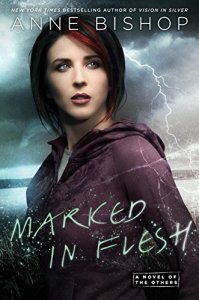Anne Bishop
Books: Fantasy
The Others: Written In Red (2013), Murder of Crows (2014), Vision In Silver (2015), Marked in Flesh (2016), Etched in Bone (2017)
Anthologies
Ruby Slippers, Golden Tears (1995), Powers of Detection (2004)
Written In Red (2013)
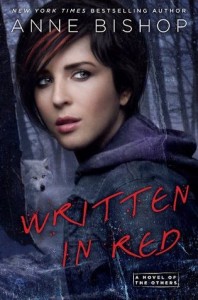 Meg Corbyn is running from those who held her for as long as she can remember. She needs a place to hide, and the Courtyard of the Others seems like the perfect place. An island of Others in the city, a place where human laws don't apply and she might be safe from the Controller who is hunting her.
Meg Corbyn is running from those who held her for as long as she can remember. She needs a place to hide, and the Courtyard of the Others seems like the perfect place. An island of Others in the city, a place where human laws don't apply and she might be safe from the Controller who is hunting her.
First, although this is an urban fantasy, it's not like much else out there right now. Humans evolved and expanded across areas controlled by Others, knowing that they were seen as prey by the others, and doing what they could to make themselves useful, so they could live in as much peaces as humans and Others were able to.
Second, this book was a gift from a friend who read it, loved it, and wanted me to read it as well. Thanks N!
With one caveat, there was an excellent, amazing book, that not only avoided the tropes of typical urban fantasy, and avoided a lot of tropes of fiction in general: the misunderstanding that comes from main characters keeping secrets and not sharing critical important knowledge.
You can't even imagine how happy this made me. Every time I thought I saw stupidity, the main characters would actually TALK and, you know, avoid the stupid misunderstandings.
Now, to the single caveat that annoyed me.
"They aren't human, will never be human. But we're going to try to get them to see at least some of us as more that useful or clever meat. Then maybe–maybe–the next time adult men act like fools and enter the Courtyard uninvited, we'll get a call instead of having to fill out a DLU form."
"I'm not sure anyone ever tried to change the dynamics between us and the Others."
Really? No one? Ever? Humans have evolved enough to have computers and cell phones, which means they've been coexisting with Others for quite some time, and NO ONE has before thought, "Hey! Maybe we should try for better relations!"? I just have a hard time believing they could have developed to they point of what was, essentially, modern society, without someone before trying to get along with the Others.
But let me be clear, that was pretty much a minor quibble compared with all the other things the story got right.
I wanted to point out this passage, which reminded me so much of my grandmother:
Meg filled their baskets, handed out treats, and breathed a sign of relief that she had just enough carrot chunks to go around. She wasn't sure they could count and would know if the last point only got one chunk instead of two, but it wasn't a chance she wanted to take.
And this passage, which cracked me up, simply because I had actually seen the second poster before, as a kid, before it was seen as politically incorrect and taken down.
(A) drawing of a cow with arrows point to the various cuts of meat popped into her head. Then she imaged a drawing of a human with the same kinds of arrows. Could there be a sign like that in the butcher shop?
To be clear, the poster I remembered seeing as of a woman in traditional pin-up pose, with her parts labeled, which is why, I'm sure, it eventually disappeared.
So all in all, this was an excellent story that I thoroughly enjoyed, and highly recommend.
Cover by Blake Morrow
- November 2013 | Rating: 8.5/10
- December 2018 | Rating: 7/10
Vision In Silver (2015)
 Somehow
I managed to skip the second book. I realized it about a third of the
way through, but decided it didn't particularly matter.
Somehow
I managed to skip the second book. I realized it about a third of the
way through, but decided it didn't particularly matter.
Meg is still in the Lakeside Courtyard, and the others have rescued the other blood prophets from those who sold their visions for a price.
That had been the reason the Others had demanded what humans called full disclosure— reveal anyplace that housed blood prophets or face extermination of the entire town that conspired to keep the girls a secret.
The world is trying to come to terms with this–and a group of humans has decided to cause trouble for the Others, in the mistaken belief that they can control the lands.
The Sanguinati will call these humans Venom Speakers because they poison other humans with their words.
The humans are wrong, but they don't know it yet.
We also learn more about how girls like Meg were treated–and it wasn't well.
"I don't remember my hair being cut," Meg said. "But sometimes I had odd dreams of things being done. The Walking Names took each of us to a room for a maintenance sleep. When I'd wake up, nothing seemed different."
But we also see that there was an original reason for the girls to be sequestered: they become overwhelmed by too much stimulus.
I'm still not sure I'm believing that Meg was able to manage as she did in the first book, but then fell apart after getting a haircut.
So it's an interesting story, and I'm reading on, but it's because I already have the next books and want to know what happens. I still have issues with some of the premises of the story.
Cover by Blake Morrow
Published by Penguin
December 2018 | Rating: 7/10
Marked in Flesh (2016)
The HFL (Humans First and Last) group has been striking against the Others, but now they want to start to take over the lands they believe rightfully belong to humans.
As far as the Others were concerned, not listening was a big reason why humans, as a species, ended up needing harsh lessons.
In Lakeside, the human pack has been growing–the humans who have attempted to work with the Others and have been ostracized by their friends, family, and co-workers.
The police have no leads as yet on the person or persons who broke windows and painted obscene suggestions on the buildings. One store owner said he was going to leave a dictionary on a public bench so the vandals could at least spell the obscenities correctly.
This book is when things come to a head, as they HFL makes their move, and the Others are completely unprepared, even with the warnings of the cassandra sangue. OK. That's not entirely true. They do listen when things come to a head, but they are all but blind to what is happening right up until that point.
Which seems ridiculous to me, since many of the Others are very long lived, and you'd think someone would passed along the word of the perfidy of humans.
There were some bits of world building I found very interesting:
"I brought some bug lotion." Merri Lee looked at Simon and made a face. "It probably smells really stinky to you, but we don't know yet how Meg will react to a bug bite, so I brought some with me."
It turns out bugs don't like the cassandra sangue, but it's an interesting thought.
I also liked the peeks as to how Hope and Jean were learning to cope with the world, especially Hope's method of alternative prophecy.
I liked the attempts to portray the kids as kids, even if sometimes things felt a little off.
In his official capacity as a lieutenant in the Lakeside Police Department, Monty placed Robert, Sarah, Lizzy, and Grr Bear under house arrest. The girls insisted that Grr Bear was innocent and that he'd tried to tell them they were playing where they weren't supposed to, but Robert wouldn't listen.… When Eve Denby stormed in and demanded he arrest the children and take them to jail for reckless endangerment and being a pain in her ass, he'd thought she was playacting and went along, especially when Pete, as the children's attorney, threw himself on the mercy of Mother Court and tried to plea-bargain.
In this book, it struck me as a bit odd that the Others took so long to respond to the Human attacks. It's made quite clear that they are distinct from humans and don't think to same, so I wasn't quite sure I believed they would wait so long to respond to the HFL attack.
It was a nice plot point, but it didn't feel particularly realistic, given that they didn't seem particularly given to planning and plotting.
Cover by Blake Morrow
Publisher: Roc
December 2018 | Rating: 7/10
Etched in Bone (2017)
 The fifth Others book, and the completion of the story arc started in the first book.
The fifth Others book, and the completion of the story arc started in the first book.
The Others have struck back at the humans and the world is once again irrevocably changed. Human communication is no longer instantaneous OR private. Humans are no longer safe to travel the at night.
In Lakeside, things are attempting to settle into a new normal in the Courtyard, except that Lieutenant Montgomery's brother shows up sowing chaos, and the Elders have decided he should remain, so they can watch him, and determine what makes him so dangerous.
So now I'm finished with the main story arc, I have some thoughts.
First, I still don't accept that humans and others have not attempted to come to an accommodation before this time. It's just not realistic. Yeah, lots of humans are flaming assholes, but not all of them. And I find it beyond the realm of probability that those humans are like us, yet in two thousand (or more) years, no one managed to make friends. I also find it exceedingly unlikely that there hadn't been Human/Other matings before.
I also find the idea that humans might have still attempted to be hostile to the others after the (deserved) massacres in the previous book. The results were spread around the world. You might be hostile and angry, but there is no way anyone sane would actually voice those opinions out loud.
All of which means I had serious problems with the underlying premises of the book. Many of these events should have happened several hundred years before (especially with the advent of the telegraph and railroads). That humanity could have developed cell phones but not succeeded in making friends with at least some of the others just seems incredibly unrealistic.
And it was hard for me to keep setting that aside to enjoy the rest of the story. Which is too bad, because I wanted to know what happened (which is why I kept reading). But I was frustrated by the way many of the Others seemed to be inconsistent. They're either mercurial or they are capable of planning a world-wide revenge. Humanity should have become friends with the others centuries before. That multiple groups of Others become friends with humans (and even multiple humans) all at the same time is again inconsistent.
If the others had been interacting with humans for hundreds (perhaps even several thousand) years, it makes no sense that the social changes would never have happened before. Nor does it make sense that the Elders would have lacked memory and record of what humans did in the past to get wiped out.
All of which means, as fascinating as I found the world-building, there were some serious weaknesses that kept me from truly enjoying the story.
Cover by Blake Morrow
Publisher: Roc
December 2018 | Rating: 7/10
Ruby Slippers, Golden Tears (1995) edited by Ellen Datlow & Terri Windling
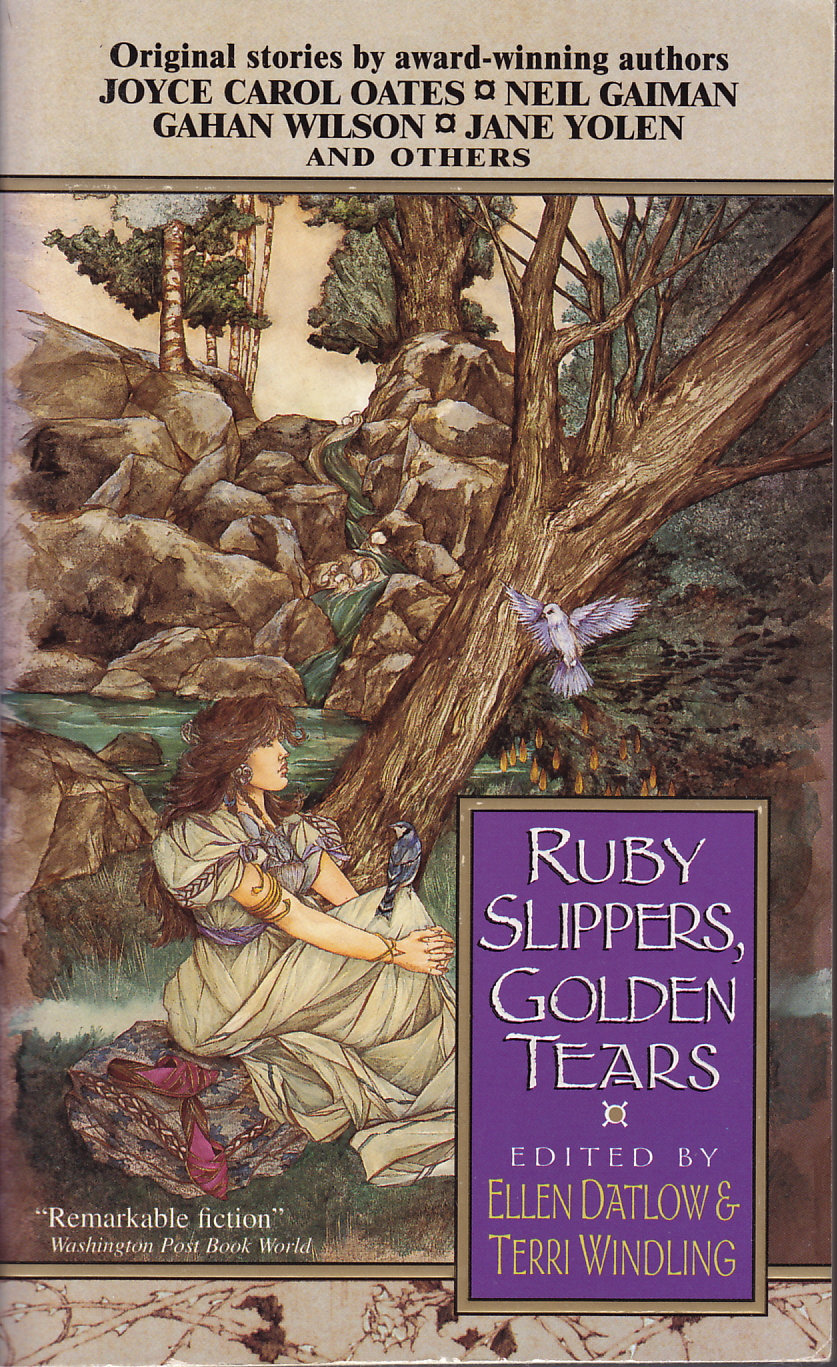
- Ruby Slippers by Susan Wade
- The Beast by Tanith Lee
- Masterpiece by Garry Kilworth
- Summer Wind by Nancy Kress
- This Century of Sleep, or Briar Rose Beneath the Sea by Farida S. T. Shapiro
- The Crossing by Joyce Carol Oates
- Roach in Loafers by Roberta Lannes
- Naked Little Men by Michael Cadnum
- Brother Bear by Lisa Goldstein
- The Emperor Who had Never Seen a Dragon by John Brunner
- Billy Fearless by Nancy A Collins
- The Death of Koshchei the Deathless by Gene Wolfe
- The Real Princess by Susan Palwick
- The Huntsman's Story by Milbre Burch
- After Push Comes to Shove by Milbre Burch
- Hansel and Grettel by Gahan Wilson
- Match Girl by Anne Bishop
- Waking the Prince by Kathe Koja
- The Fox Wife by Ellen Steiber
- The White Road by Neil Gaiman
- The Traveler and the Tale by Jane Yolen
- The Printer's Daughter by Delia Sherman
Published by Harper Collins
Black Swan, White Raven (1997) edited by Ellen Datlow & Terri Windling
 "Introduction" by Terri Windling and Ellen Datlow
"Introduction" by Terri Windling and Ellen Datlow- "The Flounder's Kiss" by Michael Cadnum
- "The Black Fairy's Curse" by Karen Joy Fowler
- "Snow in Dirt" by Michael Blumlein
- "Riding the Red" by Nalo Hopkinson
- "No Bigger Than My Thumb" by Esther M. Friesner
- "In the Insomniac Night" by Joyce Carol Oates
- "The Little Match Girl" by Steve Rasnic Tem
- "The Trial of Hansel and Gretel" by Garry Kilworth
- "Rapunzel" by Anne Bishop
- "Sparks" by Gregory Frost
- "The Dog Rose" by Sten Westgard
- "The Reverend's Wife" by Midori Snyder
- "The Orphan the Moth and the Magic" by Harvey Jacobs
- "Three Dwarves and 2000 Maniacs" by Don Webb
- "True Thomas" by Bruce Glassco
- "The True Story" by Pat Murphy
- "Lost and Abandoned" by John Crowley
- "The Breadcrumb Trail" by Nina Kiriki Hoffman
- "On Lickerish Hill" by Susanna Clarke
- "Steadfast" by Nancy Kress
- "Godmother Death" by Jane Yolen
Published by Avon
Silver Birch, Blood Moon (1999) edited by by Ellen Datlow & Terri Windling
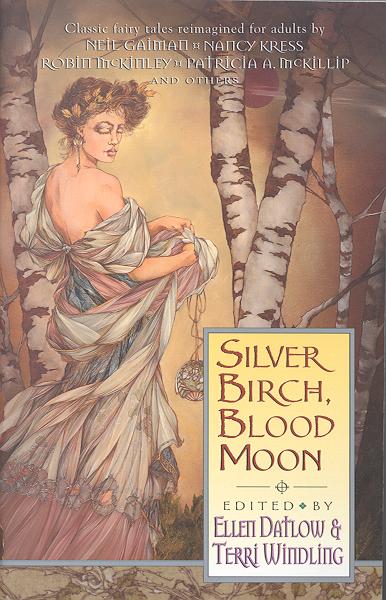 "Introduction" by Terri Windling and Ellen Datlow
"Introduction" by Terri Windling and Ellen Datlow- "Kiss Kiss" by Tanith Lee
- "Carabosse" by Delia Sherman
- "The Price" by Patricia Briggs
- "Glass Coffin" by Caitlín R. Kiernan
- "The Vanishing Virgin" by Harvey Jacobs
- "Clad in Gossamer" by Nancy Kress
- "Precious" by Nalo Hopkinson
- "The Sea Hag" by Melissa Lee Shaw
- "The Frog Chauffeur" by Garry Kilworth
- "The Dybbuk in the Bottle" by Russell William Asplund
- "The Shell Box" by Karawynn Long
- "Ivory Bones" by Susan Wade
- "The Wild Heart" by Anne Bishop
- "You Wandered Off Like a Foolish Child to Break Your Heart and Mine" by Pat York
- "Arabian Phoenix" by India Edghill
- "Toad-Rich" by Michael Cadnum
- "Skin So Green and Fine" by Wendy Wheeler
- "The Willful Child, the Black Dog, and the Beanstalk" by Melanie Tem
- "Locks" by Neil Gaiman
- "Marsh-Magic" by Robin McKinley
- "Toad" by Patricia A. McKillip
Publisher: Avon Books
Powers of Detection (2004) edited by Dana Stabenow
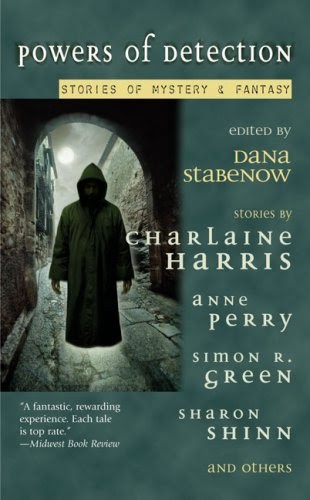 I like fantasies. I like mysteries. So… "Stories of Mystery and Fantasy" sounds like a good thing. Plus Charlaine Harris has a Sookie Stackhouse short story, and that had to be a good thing.
I like fantasies. I like mysteries. So… "Stories of Mystery and Fantasy" sounds like a good thing. Plus Charlaine Harris has a Sookie Stackhouse short story, and that had to be a good thing.
Well, it was an okay thing.
- Cold Spell by Donna Andrews
- The Nightside, Needless To Say by Simon R. Green
- Lovely by John Straley
- The Price by Anne Bishop
- Fairy Dust by Charlaine Harris
- The Judgement by Anne Perry
- The Sorcerer's Assassin by Sharon Shinn
- The Boy Who Chased Seagulls by Michael Armstrong
- Palimpsest by Laura Anne Gilman
- The Death of Clickclickwhistle by Mike Doogan
- Cairene Dawn by Jay Caselberg
- Justice Is A Two-Edged Sword by Dana Stabenow
The Charlaine Harris story was good. In "Fairy Dust," Sookie has to figure out who killed Claudine's sister, Claudia.
Having read Anne Perry's fantasy before, I skipped "The Judgement" entirely. She may write good mysteries, but what fantasy I've read has been not good.
I liked Jay Caselberg's "Cairene Dawn" even though I caught onto where he was going with it. It was fun and amusing. Anne Bishop's "The Price" was an interesting story. The setting and the world were strange, but the story was still fascinating.
I also liked Simon R. Green's "The Nightside Needless to Say," which was a quick read, and in the hard-boiled vein, which I enjoy when done well. John Straley's "Lovely" was interesting as well, seeing as how it was written from the point of view of a crow.
The other stories were for the most part okay. I didn't like "The Death of Clickclickwhistle" too much, but it was science fiction rather than fantasy, and that was the part I didn't care for, rather than the mystery.
Rating: 5/10

